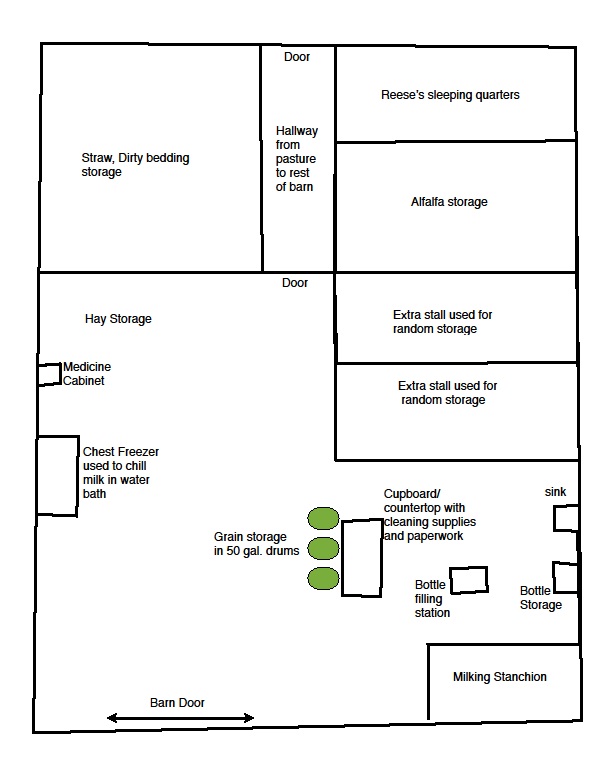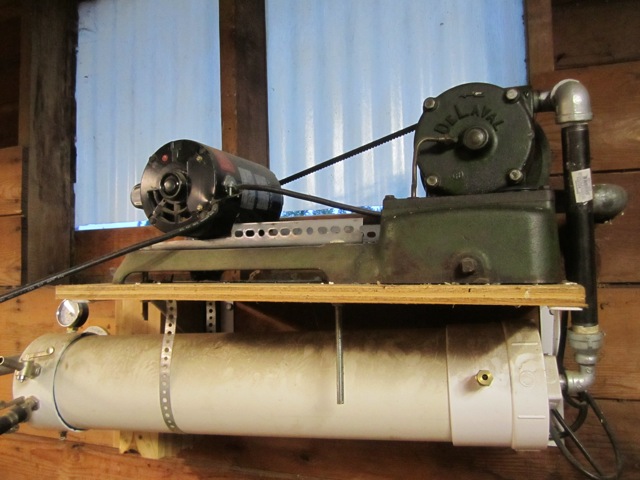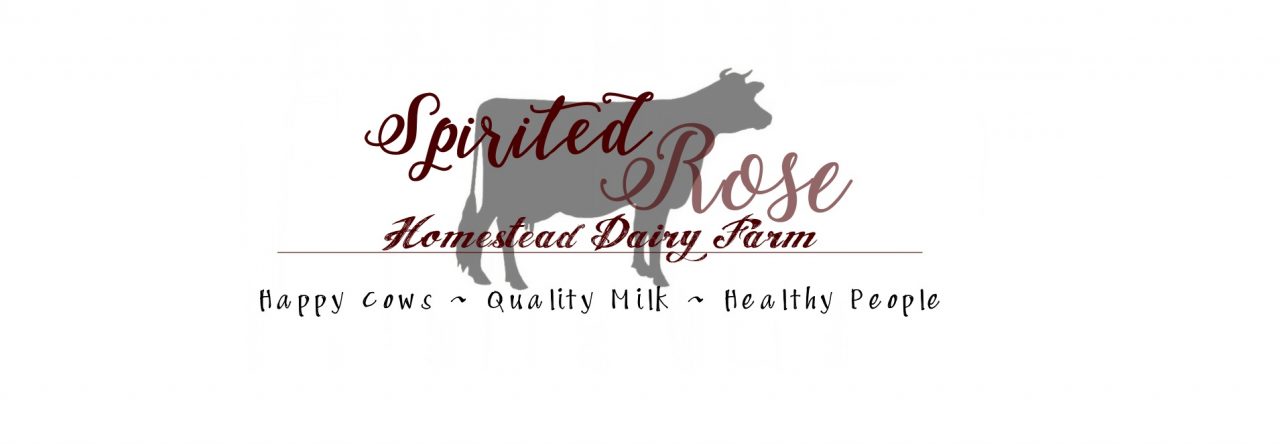
Here are a few notes from the family, in their own words:
a few things that we like about our setup are:
-chilling our milk in a water bath utilizing rubbermaid bins inside a chest freezer and plugging the chest freezer into a external thermostat to keep the water bath just above freezing.
-milking with a machine
-having water plumbed into the barn and having a small hot water heater
-having such a wonderful cow from such wonderful people (jay/michelle family hill farm)
a few things that we would want to be different:
-smaller sleeping quarters for reese. so clean up would not be such a big job.
-different bedding options. we are pretty limited to straw.
-combination of smaller sleeping quarters and wood shaving bedding would be ideal.
-a heated insulated barn.
-a floor with a drain in it.



per month average we spend $415 (or $435 with monthly medical savings):
for the past 6 months we’ve been spending close to $600 a month and more, but it’ll average out the next 6 months.
220 on hay and alfalfa
125 on grain (organic)
25 on straw/bedding
25 on supplies (filters, paper towels, wipes, dip for teets, ointment etc)
20 on medical (AI, milk testing, oils etc)
we just bought 120 bales of hay (3tons of first cutting local) for $1k. that should last through summer. we have little pasture. reese gets over an acre of pasture in the summer but we still supplement with several flakes of hay a day when she is dry (no alfalfa when they are dry, or grain for that matter)
we bought 5 tons of alfalfa (112bales) for $1413 (and had it tested and it is GREAT quality 22% protein) and that should last until summer
so that makes:
our use of alfalfa 10 months out of the year (2 months reese is dry) and approximately 11 bales a month, so about a bale every three days.
our use of grass hay 12 months out of the year , 10 bales a month, so almost a bale every three days (these bales are smaller than the alfalfa bales)… we feed more alfalfa than hay right now.
if you have pasture you are in a much better position for cutting cost on hay prices.
and, remember if you breed three months after calving, you have two months a year that your cow is dry. so, you are still incurring costs and not getting any milk.
the monthly average does not include emergency/extra medical expenses. for example; we have had to breed reese twice this year, plus have the AI tech out a couple other times to check for heat, plus give reese estrogen to get her heat regulated. that for example adds over $200 in medical expenses. last year we put her on pasture without hay supplementation which led to a magnesium deficiency which would have cost more to have the vet out but thankfully we knew some dairy folks who came over with a bolus gun and helped me give her 8 cmpk (calcium, mag, phos pills). etc so, you could add a medical savings of $15-20.00 to the monthly budget and that would help.
the monthly a√erage does not include all the start up supplies:
here are a few things that you need etc:
Jars (azure, $4each including lid roughly for gallon)
Filters (feed store or azure)
Milk Bucket
Milking system (unless you milk by hand, price varies)
Wipes (country store, chlorahexadine wipes)
Chlorahexadin (daritech)
Hoof trimming once a year (20)
Minerals (dry cow and lactating cow, complies with organic)
AI once a year ($60; clyde at select sires)
Emergency supplies (meds on hand)
Bedding (straw, sawdust)
Local Hay (we get our hay from westlyn feed, by the ton)
Alfalfa (westlyn)
Grain (in season farm, 336.50 a 1/2 ton)






So, all of these expenses if for 1 cow? I am guessing you do not get round bales of hay? How much grain do you give her daily when she is in milk? I apologize for so many questions. I just got my first dairy cow last month and $600 a month seems high to me. 1 round bale of coastal Bermuda lasts her close to a month and is $40 a bale.
LikeLike
Yes, we do buy round bales. In our area, the cost varies quite a bit, but to get something good enough quality for a milking cow costs us around $150/ton. Note – this is high quality first or third cutting pure alfalfa. A dairy cow does NOT milk well on grass alone, the protein level needs to be 16.5% or higher (generally higher in hays, because the cow does not fully digest 100% of the protein).
The generality for grain is one pound of grain per three pounds of milk (8.6 pounds in one gallon, approx.). If you’re only feeding grass hay, that “may” need to be higher. Depends on her body condition and how much she is milking.
Also, if you live in a temperate climate (where I’m guessing a coastal Bermuda grass would grow…?) Then your costs may go waaaay down if you’re able to pasture your cow most of the year. Where we live, we can only pasture 6 of the 12 months, so a dairy cow in milk needs around 5 tons of high quality hay to see her through the winter!
LikeLike
Thank you so much for getting back to me on this! Once she comes into milk, which is in June, I will start her on alfalfa. Have you ever used alfalfa cubes or pellets? I have heard that it is just as nutritious as feeding the hay. It is just chopped, compressed, and dehydrated. Alfalfa is not readily available here and has to be shipped from up north. It can get really pricey and I cannot get it in round bales. 😦 However, I am not opposed to feeding it to her if it is what is best for her. What about timothy? I know it is not as high quality as alfalfa but it is easier for me to get here.
I live in south eastern North Carolina so it is possible for me to pasture through the winter. However, I still supplement just to ensure she is getting what she needs. Next winter will be the test when she is actually milking. How much should I expect her to produce before I increase grain intake? Her mom and her both came from a creamery so she comes from very good blood lines. (I don’t have her mom)
Thank you again!!
LikeLike
The difference between pellets and hay (regardless of nutrition value) is the issue of FIBER. A dairy cow has a rumen, which is specifically designed to work with long-stemmed fiber. If you feed alfalfa pellets, you need to think of it more like a grain, in that you will need to feed some sort of long-stemmed fiber with it so the rumen can absorb the nutrients from the pellets.
In your situation, I would suggest looking into the timothy hay as her fiber source. Then a combination of alfalfa pellets (for protein) and grain (for protein and energy) should give you an acceptable base diet for a cow.
I will email you back for further discussion.
LikeLike
I am going to email you so we can chat that way. It will be coming from metamorphosisdesignstudio11@gmail.com. 🙂
LikeLike
Please watch that chlorahexadine, some people can be very allergic. I am and get terrible oozing rashes from the slightest contact.
I appreciate your great list, I was unaware this was even used on livestock.
good info, but wow on feed prices, more than 3 times our local prices.
LikeLike
If allergic to Chlorhexidine, I would suggest trying Iodine, which may be more natural.
Feed prices vary significantly depending on where people live. Before purchasing a cow, people should check into local feed prices (because they may find it much more expensive to keep a cow than to buy milk from someone else!)
LikeLike
Hi im going to be moveing and will be getting a cow seeing if you could help me with a few things ill need thanks at walker.1414@hotmail.com
LikeLike
Feel free to ask questions, I try to put as much on the website as we know, but there are always good questions out there we haven’t thought of!!
LikeLike